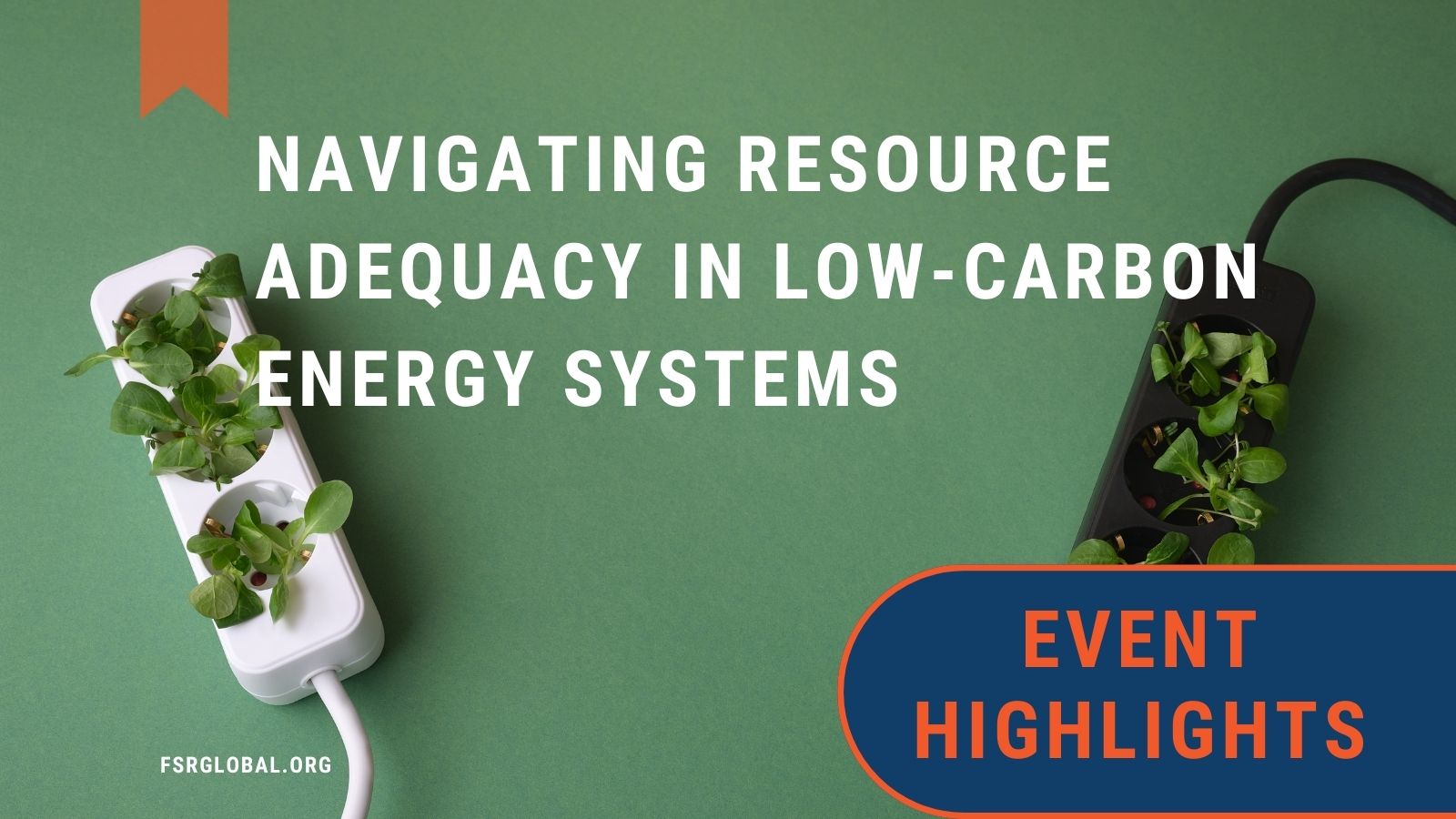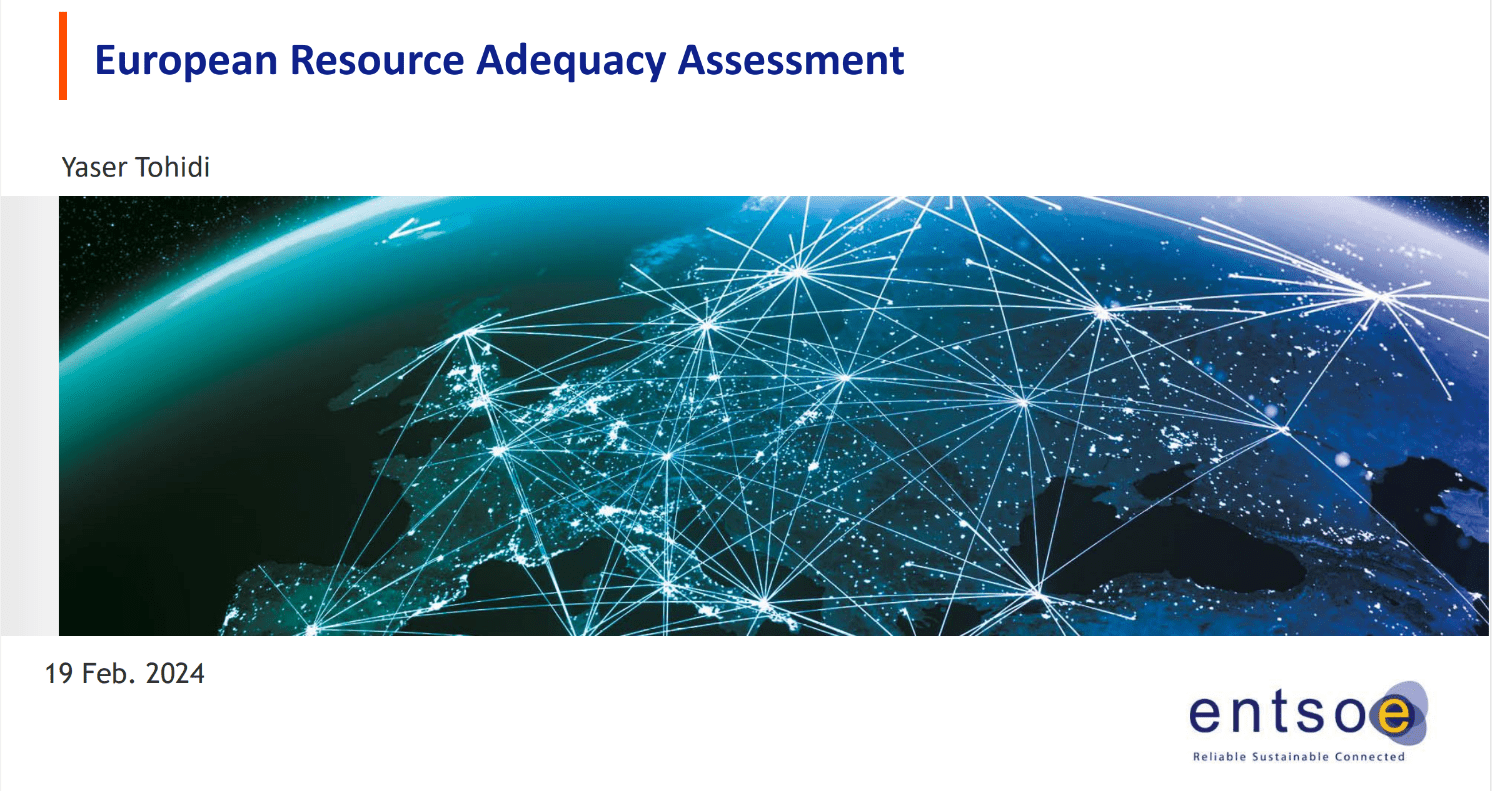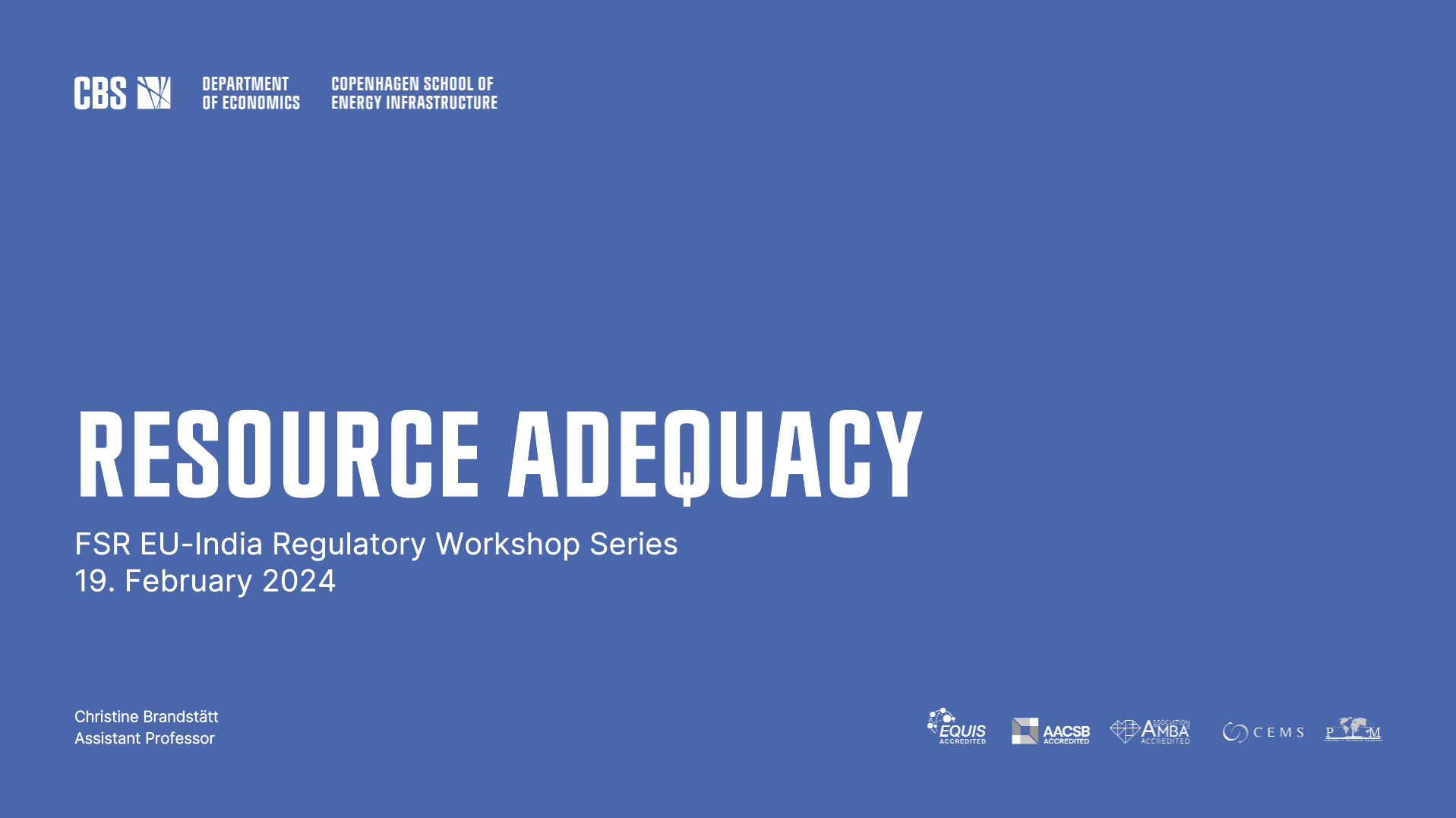Event Highlights
Navigating Resource Adequacy in Low-Carbon Energy Systems

FSR Global
EU-India Regulatory Workshop Series
March 01, 2024
FSR Global hosted a webinar on the topic of “#ResourceAdequacy” as part of the 6th EU-India Regulatory Workshop Series conducted under the EU-India Clean Energy Climate Partnership.
The speakers were Ghanshyam Prasad, Chairperson of the Central Electricity Authority; Sushil Kumar Soonee, Former CEO & Founder of POSOCO/Grid India; Yaser Tohidi, Adequacy Modelling Specialist at ENTSO-E; Christine Brandstatt, Assistant Professor at the Copenhagen School of Energy Infrastructure (CSEI); Swetha Ravi Kumar, Executive Director, FSR Global and was moderated by Dr. Parul Bakshi, Research Fellow, FSR Global.
Resource adequacy is a fundamental concept in the power sector that ensures that the power system can supply enough electricity reliably and efficiently to meet demand. This becomes particularly critical during periods of significant change, such as the ongoing transition to a more renewable energy-oriented grid. The Central Electricity Authority of India has recently issued draft guidelines to tackle the challenge of integrating renewables into the grid while maintaining reliability. In contrast, the European Union has long grappled with integrating renewables and harmonizing diverse national electricity systems into a unified European system. Europe has thereby developed the sophisticated European Resource Adequacy Assessment (ERAA), which forecasts power system adequacy up to a decade ahead. This system covers all EU member states, as well as other European countries like Switzerland and Norway. Using advanced methodologies and probabilistic assessments, it models events that could impact the supply-demand balance in the future, aiding policymakers in making strategic decisions. As we delve into the Indian proposals, drawing from the European experience could help ensure the stability and equilibrium of power systems, given their intricacy and challenges.
Evolving Approaches in Resource Adequacy Planning
The topic of resource adequacy has evolved significantly over the past few decades, particularly with the increasing integration of intermittent renewables into the energy system. One key aspect for discussion has been on how to approach resource adequacy planning within the framework of this energy transition, considering the influx of new technologies. Traditionally, resource adequacy planning has been more supply heavy. However, with the emergence of multi-directional flow of electricity, there is a need to reconsider this approach. How can we factor in these new dynamics when assessing resource adequacy?
Another important question is whether resource adequacy planning should be centralized or decentralized. Perhaps the optimal approach lies in finding the right mix of both to ensure security of supply at both country and regional levels. Data availability and transparency are also crucial for effective planning. The European experience here can offer valuable insights into how to improve data transparency platforms. India, which has just begun its journey in this area, can learn from these experiences to develop effective planning tools. Furthermore, as we transition more towards market-based procurement, it’s essential to consider market dynamics in resource adequacy planning. This means moving beyond just capacity expansion models to include network considerations and market dynamics in future assessments.
Adapting to Change: India’s Dynamic Resource Adequacy Planning Approach
India’s approach to resource adequacy planning has evolved significantly over the years, reflecting the country’s changing energy landscape and priorities. Initially, the focus was on addressing the energy deficit by rapidly adding resources to the system. However, this led to stress on some assets and negative signals to investors. Recognizing the need for a more balanced strategy, India shifted its focus to ensure both adequacy and reliability in its energy resources. This shift is crucial, especially considering the energy sector’s diverse and decentralized nature, with each state having demand profiles comparable to the European countries.
Resource adequacy planning in India has evolved from a focus on peak demand to a more holistic view that considers factors like diversity, market dynamics, and demand response. This shift is crucial, especially considering India’s diverse energy needs, which vary seasonally. Balancing centralized and decentralized approaches has been a key challenge, leading to a hybrid approach where responsibilities are shared between distribution companies and regulatory bodies.
To achieve this balance, India has adopted a dynamic planning approach, moving away from static plans made every five years to rolling plans revised annually. This new approach includes detailed planning for one to five years and a perspective plan for up to 10 years. Responsibility for resource adequacy planning is distributed among various entities, including distribution companies, regional load dispatch centers, and the national load dispatch center.
One critical aspect of India’s resource adequacy planning is its consideration of the transmission network’s adequacy. This is crucial, as a lack of proper transmission infrastructure can lead to inefficiencies and supply issues despite adequate generation capacity. India has already started revising its transmission plan every six months to accommodate the fast-paced nature of renewable energy projects and ensure the efficient integration of these resources into the grid.
Moreover, India is also exploring bi-directional grid interactions and concepts like vehicle-to-grid to enhance grid flexibility and efficiency. This involves shifting from a unidirectional grid to a bidirectional one, where consumers also play an active role in balancing the grid. Data and tools also play a crucial role in resource adequacy planning, with the need for skilled human resources to analyze and visualize complex datasets. As the energy landscape evolves with the introduction of new technologies like e-mobility and solar rooftops, the need for accurate and dynamic planning becomes even more critical.
Dynamic Resource Advocacy Planning: Ensuring Energy Security and Sustainability
The draft resource advocacy guidelines propose a strategic procurement approach, with 70% of procurement focused on long-term (10 to 20 years) contracts, 10% on medium-term contracts, and the remainder on short-term procurement. This aligns with existing practices, including the use of long-term Power Purchase Agreements (PPAs), providing stability to the energy market.
In the resource advocacy framework, emphasis is placed on securing power resources to meet both national peak demand and individual consumer needs. Each Distribution Company (DISCOM) is required to secure 100% of the power necessary to meet national peak demand, ensuring a reliable energy supply for all consumers. The importance of robust IT infrastructure for DISCOMs is also emphasized, as resource advocacy studies have become increasingly data-driven. These studies are now expected to be annual exercises, demonstrating the DISCOM’s ability to meet peak demand and ensuring transparency before the State Commission.
Resource advocacy studies differ from other planning exercises due to their dynamic nature. These studies consider factors such as Loss of Load Probability (LLP), energy not served, and capacity credit, making judgments also based on economic and financial considerations. This dynamic approach enables planners to adapt to evolving demand patterns and technological changes. Decentralized solutions, such as rooftop solar, are recognized for their potential to contribute significantly to resource adequacy. By reducing the reliance on traditional transmission and distribution infrastructure, these solutions offer a more sustainable and flexible approach to meeting energy demand.
To address uncertainties in demand patterns arising from Distributed Renewable Energy (DRE), Electric Vehicles (EVs), and other technological changes, planners advocate for regular updates to resource advocacy plans. This approach allows for the incorporation of real-time data and ensures that plans remain responsive to changing conditions.
Challenges in Resource Adequacy Planning
Resource adequacy planning faces several challenges, including the need to address forecast errors, equipment failures, and evolving demand levels and profiles. Additionally, integrating demand flexibility into planning poses a significant challenge, as assessing the reliability of demand-side resources, such as industrial processes and electric vehicles, can be complex. To address these challenges, planners use a variety of tools. Dispatchable generators are essential for short-term needs, while flexible and interruptible loads help balance the system. Storage capacity and interconnection capacity are also crucial, along with reserve and peak capacity considerations.
European Resource Adequacy Assessment (ERAA) and Future Considerations
In Europe, the ERAA is a crucial tool for assessing resource adequacy and ensuring compliance with energy targets and regulations. It helps identify potential capacity shortfalls and informs decisions on capacity mechanisms. Future resource adequacy planning will need to consider evolving market rules, regulatory frameworks, and technological advancements. Demand flexibility and the integration of renewable energy sources will continue to be key focus areas, highlighting the dynamic nature of resource adequacy planning in low-carbon energy systems.
The ERAA model, while not a capacity expansion model as a whole, includes an Economic Viability Assessment (EVA) component that considers capacity expansion over a 10-year planning horizon. This component ensures that capacity expansion aligns with economic and financial considerations. The transition to EU-level energy planning involves translating EU targets into national plans (NECPs) and ensuring compliance through data collection and public consultation. This transition aims to streamline planning processes and improve coordination among member states.
While flattening the load curve is a key objective, maintaining flexibility is essential, particularly in managing intermittent generation sources. Tariff structures and contracts can incentivize consumers to flatten their consumption, but allowances should be made for peak demands when necessary to ensure reliable supply. To manage uncertainties in demand patterns, contracted demand response mechanisms, such as industrial consumers rescheduling production to shed load, are recommended. It is believed that over time, experience with decentralized solutions will help refine planning approaches and improve the overall reliability of the system.
These points underscore the complexities and considerations involved in modern energy resource planning. Transitioning to more dynamic and flexible systems is essential to meet changing demands, incorporate decentralized solutions, and ensure the long-term sustainability and security of the energy supply.
A Holistic Approach
Addressing the challenges in energy planning requires a comprehensive approach, involving data, tools, and skill development. It’s crucial to have a clear understanding of reliability criteria and the capability to simulate and analyze different scenarios rigorously. The cost of improving planning processes is minimal compared to the costs of capacity expansion, highlighting the need for a cultural shift towards prioritizing investment in planning and skill development.
Benchmarking or mandating transmission import/export capability for each state can maximize the advantages of an interconnected system. Interconnection capacity depends on system characteristics and political dynamics, highlighting the need for careful consideration.
On the other hand, funding for capacity building is essential, as it can cover the lifetime needs for effective energy planning, and policymakers should allocate resources for tools, hardware, people, and skill development. Policymakers must not only focus on regulations but also provide resources and support for utilities to develop the necessary tools and skills.


